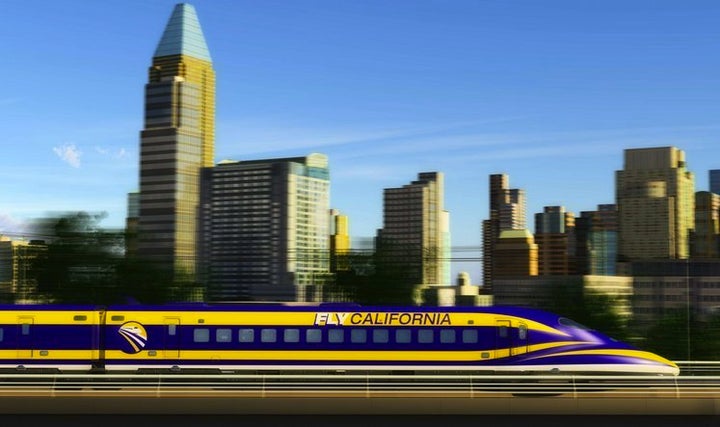
This article comes to us courtesy of California Watch.
California’s $68 billion bullet train is supposed to travel from San Francisco to Los Angeles in less than two hours and 40 minutes.
That speed – an average of more than 140 mph, including stops – is a legal requirement, written into the state voter initiative that gave the project the go-ahead in 2008.
Boosters continued to promise that the train would attain those speeds even after Gov. Jerry Brown cut $30 billion from the project’s budget earlier this year, forcing a reconfiguration that seemed likely to slow down the train.
But according to a lawsuit filed by project opponents, the state High-Speed Rail Authority has not done any studies or written reports to verify that the trains actually will go fast enough to follow the law. The suit, filed by the County of Kings Board of Supervisors, quotes a May 31 email from a project official as saying that “no document exists” to verify that the train can meet its travel time deadline.
Instead, the rail authority’s promises are backed up by “verbal assertions based on (the) skill, experience and optimism” of project engineers, the rail official wrote in response to a request for public information.
That statement “casts great doubt on the credibility” of the claims the authority is making about the bullet train, Kings County says in the lawsuit, which seeks a court order to cut off state funding for the project. The county claims constructing the rail line will wreck thousands of acres of prime Central Valley farmland.
In a statement, rail authority Chairman Dan Richard said the reconfigured or “blended” project will comply with the law.
“The law requires that the system be designed to achieve speeds of 200 miles per hour and a travel time of two hours and 40 minutes,” he said. “We embraced the blended approach based on our experts’ determination that the blended system can achieve these goals.”
The state attorney general’s office has asked a Sacramento judge to dismiss the lawsuit, arguing that opponents have presented no evidence that the rail authority is making illegal expenditures on the project. A hearing on the issue is set for Friday.
Last year, judges tossed two similar lawsuits that sought to have the project stopped on the grounds of illegal or wasteful spending.
In an interview, Michael Brady, lawyer for Kings County, contended that the rail authority has little hope of meeting its travel time requirement.
In April, when the governor slashed the project’s $98 billion construction budget, the rail authority unveiled the blended rail network plan in which high-speed trains would share tracks with Caltrain on the San Francisco Peninsula and Amtrak and Metrolink in the Los Angeles basin.
Some rail experts, including advocates of the California project, questioned how bullet train speeds could be maintained.
“All over the state … they’re going to use commuter trains, Caltrain, light rail in Stockton,” Brady said. “You’re not going to be able to get from Los Angeles to San Francisco in six hours.”
That would violate state law. But if the train is too slow, the project is doomed anyway, many experts say, because most passengers will buy a plane ticket instead.
In discussing the revised plan, Richard has been emphatic that the train will achieve the speeds the law requires. In a presentation in April in Fresno, he said: “The reason we are confident the blended-approach system, which costs $30 billion less, can work is that our engineers have told us it will achieve the performance standards the voters insisted on in the ballot measure.
“And so that means trains that can go from Los Angeles Union Station to the Transbay Terminal in San Francisco in two hours, 40 minutes. …
“This plan will achieve those standards.”
After that, Kathy Hamilton of the Community Coalition on High Speed Rail, a San Francisco Peninsula group that opposes the project, said she filed a Public Records Act request for the data underlying Richard’s claim.
There wasn’t any, she was told.
In an email, rail official Kyle Wunderli wrote: “I have an answer on your request for some documented proof of the assertions the engineers made to Dan Richard. The answer is that no document exists. These were verbal assertions based on skill, experience, and optimism and so Dan Richard went with the expertise of the engineers offering these assertions.”
Train speeds are among the most important aspects of the project, Kings County lawyer Brady said. It “makes them look ridiculous” to base their claims about train speeds on the engineers’ optimism, he said.
Brady said he suspected that there is no written material on the topic because it’s simply not possible for the reconfigured train to go fast enough to comply with the law.It would be illegal for the state to spend money on the project if that’s the case, he contends.
Lance Williams is an investigative reporter for California Watch, a project of the nonprofit Center for Investigative Reporting. Find more California Watch stories here.